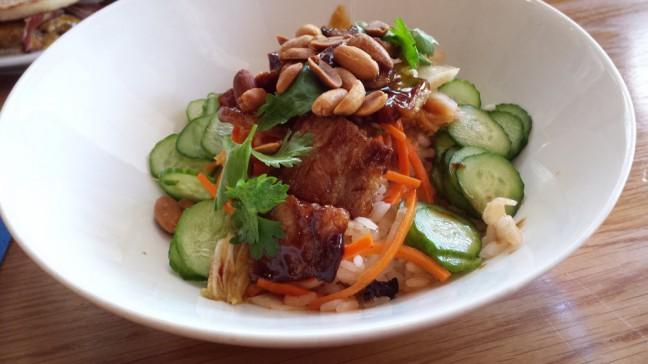Fermentation is no longer a topic relegated exclusively to microbiology textbooks. Fermented foods are surging in popularity amongst area chefs, health conscious foodies and everyone with the taste buds to appreciate the deliciousness of good bacteria and wild yeasts.
Dismiss those developing reservations and open your mind to the fascinating process of fermentation. There’s a reason folks are feasting on symbiotic colonies of bacteria and yeast. New Year diet resolutions be gone. Once you dabble with these fermented foods, you’ll be eating deliciously and nutritiously with ease.
Kombucha
This refreshing fermented tea beverage contains the aforementioned symbiotic colonies of bacteria and yeast, most commonly referred to as SCOBY. While these little bits of SCOBY appear as a gelatinous mass at the bottom of your drink, they play the key role of fermenting the tea and sugars in the Kombucha, making it fizzy. And thanks to the SCOBY, the majority of the sugars are used up during the fermentation process so very little sugar remains in the finished product.
On top of the low sugar content, this effervescent beverage is rife with probiotics and beneficial acids, which aid in digestion, detoxify the body and bolster overall health. Kombucha is essentially a healthified version of soda, and lucky for us we’ve got NessAlla Kombucha craft-brewing this good stuff right here in Madison. They tout flavors such as Hibiscus Ginger Cardamom, Raspberry, Peach Blush and Juniper Rose, and each one is better than the next. It’s sold at dozens of local cafes, restaurants and grocers around town and all over Wisconsin, so there’s no excuse to not experience this fermented magic.
Kefir
It’s tart, tangy and, of course, fermented. This cultured milk smoothie contains a hearty dose of probiotics and is high in protein, calcium and Vitamin D. One sip and you’ll note an unexpected effervescence. Yes, it’s bubbly milk. It’s during the fermentation process that the milk’s lactose breaks down into ethanol and carbon dioxide, which results in a carbonated taste. As a result, very little lactose remains in kefir. Therefore, people with lactose intolerance often turn to kefir as a stand-in for typical lactose-containing dairy beverages.
Strawberry banana, coconut chia, chocolate truffle and dozens of other varieties of kefir are readily available in grocery stores, making it easy to snack smartly and tastefully. Though, if you’re feeling adventurous and in the mood for a DIY it’s fairly simple to make your own kefir at home. Willy Street Co-op spells out this process and sells the kefir grains you’ll need to make your own from scratch.
Tempeh
Tofu has some competition. While tempeh and tofu are both meatless sources of protein, tempeh has what tofu lacks: it’s fermented. Yes, tempeh is made by fermenting whole soybeans into dense chewy blocks, which gives the popular soy product a slightly nutty flavor and a texture more reminiscent of meat. Because of its fermentation process, tempeh is also less processed and contains more protein and fiber than tofu. Where can you try this fantastically fermented food, you ask? Tempeh often serves as a stand in for bacon and we’ve got a handful of gems in Madison that are mastering a spoof on the traditional BLT:
– The tempeh bacon on the BLT sandwich at Ladonia Café food cart is house made. Enough said.
– The TLT at The Green Owl (read: BLT with tempeh instead of bacon) is a must try. Smoky baked tempeh, lettuce, tomato and avocado are all served up on Madison sourdough wheat bread with a vegan aioli. This sandwich will leave you wondering why you ever wanted bacon in the first place.
– There are tempeh dishes galore at Bandung Indonesian restaurant begging to be eaten. Lemon grass and palm sugar, sweet peanut sauce and cucumber — the flavor combinations are hard to resist and you don’t have to. Oh, and they make their own tempeh bacon, which you can find at other local businesses like on the TLT at Monty’s Blue Plate Diner. Talk about a delicious collaboration.
Kimchi
Often described as spicy and sour, there are plenty of spots in Madison offering this traditional fermented Korean side dish. Make a stop at Asian fusion restaurant Sujeo, Korean-inspired Sol’s On the Square or local gastropub Graze and you’ll find expertly prepared varieties of fermented vegetables.
The versatility of kimchi is what makes it most interesting. It can be served as a stand-alone side dish or as a supplemental part of an entrée. From cabbage and scallions, to radishes, beets and carrots, fermented vegetables are increasingly prevalent on restaurant menus spanning across a range of cuisines. Because it uses various vegetables, kimchi is quite high in fiber and nutrients, yet low in calories. Featuring flavors such as garlic, salt, vinegar and other spices, it’s amazing that something so delicious can be so beneficial to overall health.


